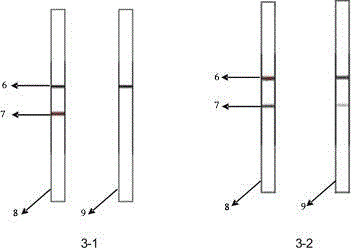Hybridoma cell line 3G1 and anti-alfatoxin B1 monoclonal antibody produced by the same
A hybridoma cell line and aflatoxin technology, which is applied to the methods using virus/cell lines, methods based on microorganisms, microorganisms, etc., can solve the problems of high degree of purification, cumbersome operation, and time-consuming detection process, and achieve specificity Good performance and high sensitivity
- Summary
- Abstract
- Description
- Claims
- Application Information
AI Technical Summary
Problems solved by technology
Method used
Image
Examples
Embodiment 1
[0020] Example 1: Screening of hybridoma cell line 3G1
[0021] 1. Antigen Synthesis and Animal Immunization
[0022] Purchase commercially available aflatoxin B1 standard substance for complete antigen synthesis, the specific synthesis steps are as follows: dissolve 4 mg AFB1 in 2 mL acetone, add 40 μL 10% H 2 SO 4 , the mixture was stirred at 56 °C for 4 h; after the product was evaporated to dryness, 5 mL of H 2 O, extracted twice with 25 mL chloroform, then with 20 mL H 2 The organic layer was washed with O, and the organic layer was retained; the organic solvent was evaporated to obtain a yellow solid product. Take 1.0 mg product, add 2 mL 0.5% BSA solution (20 mg BSA dissolved in 4 mL PBS (phosphate buffer, pH7.4)) to react at 37 °C for 30 min; add 100 μL 6.5 mM NaBH 4 , react at 4°C for 30 min; add 50 μL of 0.1mol / L HCl to remove excess NaBH 4 . At 4°C, dialyze PBS solution (phosphate buffered saline, pH 7.4) for 3 days to remove AFB1 and AFB 2a , and finally car...
Embodiment 2
[0029] Embodiment 2: Anti-aflatoxin B1 monoclonal antibody hybridoma cell line 3G1 antibody variable region sequence determination
[0030] (1) Extract total RNA: use the total RNA extraction kit from Tiangen Company and follow the instructions to extract the total RNA that can produce hybridoma cell line 3G1;
[0031] (2) cDNA synthesis: using the total RNA obtained in step 1 as a template, oligo (dT) 15 For primers, follow SuperScript TM -2 II Reverse Transcriptase Instructions for reverse transcription to synthesize the first strand of cDNA; primer oligo (dT) 15 Purchased from Invitrogen;
[0032] (3) Cloning of variable region genes by PCR method: Design primers according to the conserved sites of mouse antibody gene sequences in GENEBANK, and use cDNA as a template to amplify antibody light and heavy chain variable region genes. The PCR program was: 94°C for 30s, 55°C for 1min, 72°C for 1min, 30 cycles of amplification, and finally 72°C for 10min. After the PCR produ...
Embodiment 3
[0034] Example 3: Preparation, purification, subtype and identification of anti-aflatoxin B1 monoclonal antibody
[0035] The anti-aflatoxin B1 monoclonal antibody hybridoma cell line 3G1 obtained in Example 2 was injected into BALB / c mice that had been treated with Freund's incomplete adjuvant in advance, and the ascites of the mice was collected, and caprylic acid-ammonium sulfate was used to The antibody was purified by the method, and the specific operation was as follows: filter the mouse ascites with double-layer filter paper, centrifuge at 12000r / min for 15min at 4°C, absorb the supernatant, mix the obtained ascites supernatant with 4 times the volume of acetate buffer, and stir slowly Add n-octanoic acid, the volume of n-octanoic acid required per milliliter of ascites is 33 μL, mix at room temperature for 30 minutes, let stand at 4°C for 2 hours, then centrifuge at 12,000 r / min for 30 minutes at 4°C, discard the precipitate, and filter the obtained supernatant with dou...
PUM
| Property | Measurement | Unit |
|---|---|---|
| Particle size | aaaaa | aaaaa |
| Sensitivity | aaaaa | aaaaa |
Abstract
Description
Claims
Application Information
 Login to View More
Login to View More - R&D
- Intellectual Property
- Life Sciences
- Materials
- Tech Scout
- Unparalleled Data Quality
- Higher Quality Content
- 60% Fewer Hallucinations
Browse by: Latest US Patents, China's latest patents, Technical Efficacy Thesaurus, Application Domain, Technology Topic, Popular Technical Reports.
© 2025 PatSnap. All rights reserved.Legal|Privacy policy|Modern Slavery Act Transparency Statement|Sitemap|About US| Contact US: help@patsnap.com



